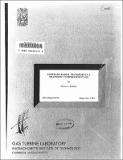| dc.contributor.author | Kotidis, Petros Anestis | en_US |
| dc.contributor.other | Massachusetts Institute of Technology. Gas Turbine Laboratory | en_US |
| dc.date.accessioned | 2016-10-06T21:22:18Z | |
| dc.date.available | 2016-10-06T21:22:18Z | |
| dc.date.issued | 1989 | en_US |
| dc.identifier.uri | http://hdl.handle.net/1721.1/104738 | |
| dc.description | September 1989 | en_US |
| dc.description | Includes bibliographical references (pages 212-219) | en_US |
| dc.description.abstract | A technique, based on the operation of a dual-hot wire-aspirating probe with frequency response of at least 18 kHz and uncertainty less than 0.005 to full scale in mass fraction units, has been developed to measure time resolved concentration in unsteady, compressible flows. The goal of the experimental part of this research effort was to obtain time resolved measurements of spanwise transport in a transonic compressor. This was achieved by injecting a circumferentially oriented, thin sheet of tracer gas in front of the compressor and detecting the foreign fluid molecules at the rotor exit The experiments were conducted at the MIT Blowdown Facility using the Air Force High Through Flow Compressor Stage as the test article. During a preliminary data reduction procedure, it was discovered that the signals from the probe's hot wires lag in time with respect to the signal from the companion total pressure probe. | en_US |
| dc.description.abstract | A correction incorporated in the data reduction schemes to account for this, eliminated most of the negative entropy regions observed in previous experiments with this probe. Several conclusions have been drawn from the experimental observations. First, up to 5% of the compressor mass flow moved along the blade span. Second, the migrating fluid was found primarily in the blade wakes at the measurement location. Third, this fluid moved towards both hub and tip in the blade wakes. Fourth, the radially convected fluid had high entropy, much higher than that of the average flowfield. Fifth, the "inviscid core" fluid moves preferentially towards the suction side of the blade passage and away from the pressure side. A simple model was developed to explain the spanwise fluid transport Gertz's 2-D wake vortex street model was extended into a quasi 3-D form. | en_US |
| dc.description.abstract | The 2-D model was fitted to the data at four spanwise locations and the spanwise variation of the parameters of the vortex street (such as vortex strength and core size) were determined. The model fit showed the shedding frequencies to be the same [17 (+/-) 0.4 kHz] at all four spanwise locations, suggesting that the vortex shedding is coherent along the span. The spanwise pressure gradient created by the variation of vortex strength led to substantial spanwise transport in the vortex cores. The model predicted the transport to the hub, but underestimated the transport to the tip by a factor of five. The measured spanwise transport can explain the previously observed discrepancy between predicted (viscous+normal shock losses) and measured spanwise distributions of adiabatic efficiency in the tip regions of transonic compressors (assuming the radial outflow to be primarily in regions of separated flow on the blades). | en_US |
| dc.description.sponsorship | Supported by the Air Force Office of Scientific Research | en_US |
| dc.format.extent | 335 pages | en_US |
| dc.publisher | Cambridge, Mass. : Gas Turbine Laboratory, Massachusetts Institute of Technology, [1989] | en_US |
| dc.relation.ispartofseries | GTL report #199 | en_US |
| dc.subject.lcc | TJ778.M41 G24 no.199 | en_US |
| dc.subject.lcsh | Compressors | en_US |
| dc.subject.lcsh | Gas dynamics | en_US |
| dc.title | Unsteady radial transport in a transonic compressor stage | en_US |
| dc.title.alternative | Transonic compressor stage, Unsteady radial transport in a | en_US |
| dc.type | Technical Report | en_US |
| dc.identifier.oclc | 21504089 | en_US |
